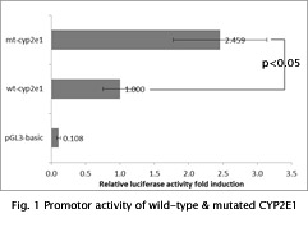Print version
Search Pub Med
Roles of CYP2E1 Enzyme in Cyclosporine Induced Liver Injury The incidence of cyclosporine-induced liver injury is about 30%, but its mechanism still remains unknown. Changes in CYP2E1 stereo structure make the enzyme-drug complexes unstable leading to oxidative stress and induction of drug-induced liver injury (DILI). The aim of this study was to investigate whether single nucleotide polymorphisms (SNPs) of CYP2E1 relate to DILI with cyclosporine. A total of 322 subjects, who were orally taking regular oral cyclosporine were recruited and divided into a DILI and control group according to the results of liver function tests. DILI was defined as: an increase over two times the upper limit of normal (ULN) in ALT or a combined increase in AST and total bilirubin, provided one of them was more than two times over ULN. The odds ratios (OR) of the CYP2E1 tag SNPs(tSNPs) were calculated using the conditional logistic regression model and differences of the tSNPs were calculated using the Chi-square test, following the Hardy-Weinberg equilibrium test for linkage disequilibrium analysis. The results show that rs3813866 (-1563 T>A) is a high risk SNP for developing DILI after Bonferroni correction (OR: 2.325, 95% CI: 1.491-3.626, Table 1). Further studies were conducted to explore how the susceptible SNP regulates the transcription and expression of CYP2E1. A mutated plasmid vector carrying rs3813866 was transferred by site mutation technology into HepG-2 cells, and the promoter activity and mRNA of CYP2E1 were detected and compared with those of wild-type by dual-reporter gene and real-time PCR methods. The results illustrated that the promoter activity of mutated-type of CYP2E1 was 2.46-fold increased over the wild type (Fig. 1), and the mRNA increased by 1.64-fold. Table 1 Association of CYP2E1 tSNPs with DILI
In summary, the rs3813866 (-1563 T>A) variant is a susceptible SNP for cyclosporine-induced liver injury through up-regulation the promoter activity and increased protein expression. (1) Tang K et al. (2010). Genomics. 95: 224-229 (2) Toscano E et al. (2010). Gastroenterol Hepatol. 33:54-65
|
|||||||||||||||||||||||||||||


